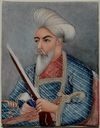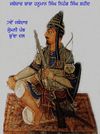Difference between revisions of "Battle of Naushera"
| Line 2: | Line 2: | ||
====Initial take over of Peshawar==== | ====Initial take over of Peshawar==== | ||
[[File:Jamrūd Fort near the Khyber WDL11467.png|thumb|[[Jamrud Fort]] near the [[Khyber]], 19th century]] | [[File:Jamrūd Fort near the Khyber WDL11467.png|thumb|[[Jamrud Fort]] near the [[Khyber]], 19th century]] | ||
| − | Ranjit Singh got an opportunity to try to takeover the Pathan capital in 1818 after finding the Afghan frontier left open during the civil war and murder of Wazir Fateh Khan, the ruler of the [[Peshawar]] region. Initially Ranjit Singh asked Akali Phula Singh who was familiar with Attock and his surroundings for his advice regarding the situation<ref>{{cite book|last1=Singh|first1=Kartar|title=Stories from Sikh History: Book-VII|date=1975|publisher=Hemkunt Press|location=New Delhi|page=130}}</ref> Akali Phula Singh told him of how the [[Khyber Pass]] is used as a gateway to Punjab and a way to block alliance between Pathan and Afghani soldiers. Ranjit Singh immediately made the decision to attack. The high ranking generals in this attack would be General Hari Singh Nalwa and Akali Phula Singh. | + | Ranjit Singh got an opportunity to try to takeover the Pathan capital in 1818 after finding the Afghan frontier left open during the civil war and murder of Wazir Fateh Khan, the ruler of the [[Peshawar]] region. Initially Ranjit Singh asked [[Akali Phula Singh]] who was familiar with Attock and his surroundings for his advice regarding the situation<ref>{{cite book|last1=Singh|first1=Kartar|title=Stories from Sikh History: Book-VII|date=1975|publisher=Hemkunt Press|location=New Delhi|page=130}}</ref> Akali Phula Singh told him of how the [[Khyber Pass]] is used as a gateway to Punjab and a way to block alliance between Pathan and Afghani soldiers. Ranjit Singh immediately made the decision to attack. The high ranking generals in this attack would be General Hari Singh Nalwa and Akali Phula Singh. |
Sirdar Yar Mohhamand Khan and [[Dost Mohammad Barakzai|Dost Mohammad Azim Khan]], the Wazir of Kabul and head of the [[Barakzai]] tribe, were in charge of the city when the Sikh army approached. They quickly fled to the [[Yusufzai]] hills. After the Sikhs took over the city it was given to Jehandad Khan<ref>{{cite book|last1=Bhatia|first1=H.S.|last2=Bakshi|first2=S.R.|title=Encyclopaedic History of the Sikhs and Sikhism: 4 Maharaja Ranjit Singh|date=1999|publisher=Deep & Deep Publications Pvt. Ltd.|location=New Delhi|isbn=81-7629-133-1|page=91}}</ref> However when Ranjit Singh returned to Lahore Yar Mohammad quickly reconquered the city. Ranjit Singh almost immediately sent another expedition to Peshawar. Yar Mohammad accepted the rule of the Sikh Raj and agreed to pay a tax of Rs. 50,000<ref>{{cite book|last1=Chhabra|first1=G. S.|title=Advance Study in the History of Modern India (Volume-2: 1803-1920)|date=2005|publisher=Lotus Press|location=New Delhi|isbn=81-89093-07-X|page=115|edition=Revised Edition}}</ref> to the empire. The neighbouring cities of [[Darband, Khyber Pakhtunkhwa|Darband]], Mankerah, [[Dera Ismail Khan]], and [[Dera Ghazi Khan]] were also added to the Sikh Raj.<ref>{{cite book|last1=Bakshi|first1=S.E.|last2=Pathak|first2=Rashmi|title=Punjab Through the Ages: Volume 2|date=2007|publisher=Sarup & Sons|location=New Delhi|isbn=81-7625-738-9|page=189|edition=1st Edition}}</ref> | Sirdar Yar Mohhamand Khan and [[Dost Mohammad Barakzai|Dost Mohammad Azim Khan]], the Wazir of Kabul and head of the [[Barakzai]] tribe, were in charge of the city when the Sikh army approached. They quickly fled to the [[Yusufzai]] hills. After the Sikhs took over the city it was given to Jehandad Khan<ref>{{cite book|last1=Bhatia|first1=H.S.|last2=Bakshi|first2=S.R.|title=Encyclopaedic History of the Sikhs and Sikhism: 4 Maharaja Ranjit Singh|date=1999|publisher=Deep & Deep Publications Pvt. Ltd.|location=New Delhi|isbn=81-7629-133-1|page=91}}</ref> However when Ranjit Singh returned to Lahore Yar Mohammad quickly reconquered the city. Ranjit Singh almost immediately sent another expedition to Peshawar. Yar Mohammad accepted the rule of the Sikh Raj and agreed to pay a tax of Rs. 50,000<ref>{{cite book|last1=Chhabra|first1=G. S.|title=Advance Study in the History of Modern India (Volume-2: 1803-1920)|date=2005|publisher=Lotus Press|location=New Delhi|isbn=81-89093-07-X|page=115|edition=Revised Edition}}</ref> to the empire. The neighbouring cities of [[Darband, Khyber Pakhtunkhwa|Darband]], Mankerah, [[Dera Ismail Khan]], and [[Dera Ghazi Khan]] were also added to the Sikh Raj.<ref>{{cite book|last1=Bakshi|first1=S.E.|last2=Pathak|first2=Rashmi|title=Punjab Through the Ages: Volume 2|date=2007|publisher=Sarup & Sons|location=New Delhi|isbn=81-7625-738-9|page=189|edition=1st Edition}}</ref> | ||
Latest revision as of 15:01, 27 October 2019
Contents
Battles of Peshawar
Initial take over of Peshawar
Ranjit Singh got an opportunity to try to takeover the Pathan capital in 1818 after finding the Afghan frontier left open during the civil war and murder of Wazir Fateh Khan, the ruler of the Peshawar region. Initially Ranjit Singh asked Akali Phula Singh who was familiar with Attock and his surroundings for his advice regarding the situation[1] Akali Phula Singh told him of how the Khyber Pass is used as a gateway to Punjab and a way to block alliance between Pathan and Afghani soldiers. Ranjit Singh immediately made the decision to attack. The high ranking generals in this attack would be General Hari Singh Nalwa and Akali Phula Singh.
Sirdar Yar Mohhamand Khan and Dost Mohammad Azim Khan, the Wazir of Kabul and head of the Barakzai tribe, were in charge of the city when the Sikh army approached. They quickly fled to the Yusufzai hills. After the Sikhs took over the city it was given to Jehandad Khan[2] However when Ranjit Singh returned to Lahore Yar Mohammad quickly reconquered the city. Ranjit Singh almost immediately sent another expedition to Peshawar. Yar Mohammad accepted the rule of the Sikh Raj and agreed to pay a tax of Rs. 50,000[3] to the empire. The neighbouring cities of Darband, Mankerah, Dera Ismail Khan, and Dera Ghazi Khan were also added to the Sikh Raj.[4]
Grandeur battle of Peshawar
In 1823 Dost Muhammad Azim Khan peacefully takes over Peshawar from his brother Sirdar Yar Mohammand Khan who was under the rule of Ranjit Singh's raj. Muhammad Azim Khan declares Jihad against the Sikh empire and Islamic religious teachers motivated around 25,000[5] jehadi pathans to join under Mohammad Azim Khan army. Ranjit Singh preparing to recapture the ancient city sent 2,000 horsemen under Kanwar Sher Singh and Diwan Kirpa Ram to check the advance of Afghans. Another army division was sent under Hari Singh Nalwa to help the first group. Next Maharajah alongside Akali Phula Singh, Sardar Desa Singh Majithia, Sardar Fateh Singh Ahluwalia joined and reached Attock.[6]
Sher Singh and Hari Singh crossed the Attock river via a boat bridge and took over the Jahangira fort after a small battle. Mohammmad Azim Khan dispatched an army of Ghazis under Dost Muhammad Khan and Jabbar Khan to fight against the Sikhs near Jahangira. Mohammad Azim Khan also destroyed the boat bridge at Attock so Mahajarah Ranjit Singh and his army would not be able to cross. Maharajah Ranjit Singh started construction of new bridge but he quickly received the news that a large number of Ghazis had encircled his army across the river and the Khalsa army had a chance of being wiped out there. Maharajah Ranjit Singh ordered the army to swim across the river and the Sikh forces were successful without much loss of men and luggage and Maharajah Ranjit Singh reached Jahangira.[7] During this time Jai Singh Attariwala who had left the Sikh Army in 1821 and joined Azim Khan came back to Ranjit Singh who instantiated him into his former rank. Here the army was strategically divided into three formations. 800 cavalry and 700 infantry soldiers was placed under Akali Phula Singh.[8]
Akali Phula Singh's Martyrdom
The army prepared to storm Peshawar and Sikh army come together to do an Ardas to Akal Purakh asking for their victory and to formalize their upcoming departure to the battlefield. Upon the completion of the ceremony Ranjit Singh heard news of the delay of General Ventura and the Sikh artillery and cannons so he told his army to stop and tried to tell the Nihang army to stop the planned attack. Akali Phula Singh refused to break the Khalsa's Gurmata made in the presence of Guru Granth Sahib to fight tonight and to fight to the last without turning back.[9][10] He told Ranjit Singh to do what he may with his army but the Nihangs are leaving for battle now and wont turn back. The Akalis thus entered the battlefield first. The Nihangs charged at the army on horseback but when the reached the army they abandoned their horses and fought through the enemies with swords. Ranjit Singh seeing the Nihangs successful charge and also seeing how the Nihangs were out numbered on the battlefield ordered the rest of the army to enter the battlefield. Prince Kharak Singh's army now charged at the enemy and General Ventura had now also arrived. Ranjit Singh ordered General Balu Bahadur's Gurkha army to attack the enemy from behind.
In the Uoper Desh region after severe hand to hand combat Akali Phula Singh was wounded in the leg so he came back to fight on a horse. Whilst fighting on horse his horse got shot so he came back to the battlefield on in howdah on the elephant[11] upon which he would be fired down and attain martyrdom. Around this time General Ventura, Hari Singh Nalwa, and Sirdar Budh Singh attacked Muhammad Azim Khan's army. When the Ghazis heard that Azim Khan ran away they lost hope and were quickly defeated. The Sikhs chased away any surviving enemies and after winning the battle the news of Akali Phula Singhs death spread around the army. Ranjit Singh with tears in his eyes along with the other Sirdars reached where Akali Phula Singhs body was lying in the howdah. Ranjit Singh covered his body with a shawl and returned to his campsite in dismay. The next day Akali Phula Singh was cremated and his ashes deposited in the Lunda river.[12] Akali Phula Singh was succeeded by Jathedar Baba Hanuman Singh Nihang.
- ↑ Singh, Kartar (1975). Stories from Sikh History: Book-VII. New Delhi: Hemkunt Press. p. 130.<templatestyles src="Module:Citation/CS1/styles.css"></templatestyles>
- ↑ Bhatia, H.S.; Bakshi, S.R. (1999). Encyclopaedic History of the Sikhs and Sikhism: 4 Maharaja Ranjit Singh. New Delhi: Deep & Deep Publications Pvt. Ltd. p. 91. ISBN 81-7629-133-1.<templatestyles src="Module:Citation/CS1/styles.css"></templatestyles>
- ↑ Chhabra, G. S. (2005). Advance Study in the History of Modern India (Volume-2: 1803-1920) (Revised Edition ed.). New Delhi: Lotus Press. p. 115. ISBN 81-89093-07-X.CS1 maint: extra text (link)<templatestyles src="Module:Citation/CS1/styles.css"></templatestyles>
- ↑ Bakshi, S.E.; Pathak, Rashmi (2007). Punjab Through the Ages: Volume 2 (1st Edition ed.). New Delhi: Sarup & Sons. p. 189. ISBN 81-7625-738-9.CS1 maint: extra text (link)<templatestyles src="Module:Citation/CS1/styles.css"></templatestyles>
- ↑ Torrens-Spence, Johnny (2006). Historic Battlefields of Pakistan. Oxford University Press. p. 31. ISBN 978-0195978971.<templatestyles src="Module:Citation/CS1/styles.css"></templatestyles>
- ↑ Singh, Bhagat (1990). Maharaja Ranjit Singh and His Times. Delhi: Sehgal Publishing Service. p. 88.<templatestyles src="Module:Citation/CS1/styles.css"></templatestyles>
- ↑ Torrens-Spence, Johnny (2006). Historic Battlefields of Pakistan. Oxford University Press. p. 32. ISBN 978-0195978971.<templatestyles src="Module:Citation/CS1/styles.css"></templatestyles>
- ↑ Samra, Mandeep (2004). Modern Sikh Historiography. K.K. Publications. p. 61.<templatestyles src="Module:Citation/CS1/styles.css"></templatestyles>
- ↑ Singh, Kartar (1975). Stories from Sikh History: Book-VII. New Delhi: Hemkunt Press. p. 138.<templatestyles src="Module:Citation/CS1/styles.css"></templatestyles>
- ↑ Singh, Prem (1926). Baba Phoola Singh Ji 'Akali' (4th Edition ed.). Ludhiana: Lahore Book Shop. p. 76. ISBN 81-7647-110-0.CS1 maint: extra text (link)<templatestyles src="Module:Citation/CS1/styles.css"></templatestyles>
- ↑ Singh, Kartar (1975). Stories from Sikh History: Book-VII. New Delhi: Hemkunt Press. p. 138.<templatestyles src="Module:Citation/CS1/styles.css"></templatestyles>
- ↑ Singh, H.S. (2008). Sikh Studies, Book 7 (Fifth ed.). New Delhi: Hemkunt Press. p. 37. ISBN 9788170102458.<templatestyles src="Module:Citation/CS1/styles.css"></templatestyles>


